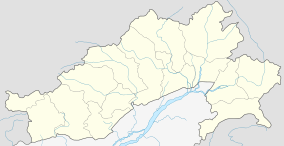Mehao Wildlife Sanctuary
| Mehao Wildlife Sanctuary | |
|---|---|
 Arunachal Pradesh, India/Tibet Autonomous Region, China | |
| Location | Lower Dibang Valley district, Arunachal Pradesh, India/Mêdog County, Tibet Autonomous Region, China |
| Coordinates | 28°15′00″N 93°30′00″E / 28.25000°N 93.50000°ECoordinates: 28°15′00″N 93°30′00″E / 28.25000°N 93.50000°E |
| Area | 282 km2 (109 sq mi) |
| Established | 1980 |
| http://roing.nic.in/wildlife.htm | |
Mehao Wildlife Sanctuary is a 282-square-kilometre (109 sq mi) wildlife sanctuary in the Lower Dibang Valley district of Arunachal Pradesh, a state in Northeast India. The sanctuary was declared in 1980, and is home to many species of wild animals including the Bengal tiger, hoolock gibbon, leopard and clouded leopard.
Geography
An area of about 282 square kilometres (109 sq mi) comprises the sanctuary between latitudes of 28°5'- 28°15'N & longitude of 93°30'-95°45'E, with the mainly hilly terrain ranging in altitude from 400 metres (1,300 ft) above mean sea level to 3,568 metres (11,706 ft) above mean sea level.[1]
Flora
The sanctuary includes four forest types, including tropical evergreen forests up to an altitude of 900 metres (3,000 ft), sub-tropical and temperate forests, from 900 metres (3,000 ft) above mean sea level to 1,800 metres (5,900 ft) above mean sea level, temperate broadleaf forest from 1,800 metres (5,900 ft) above mean sea level to 2,800 metres (9,200 ft) above mean sea level, and temperate coniferous forest from 2,800 metres (9,200 ft) above mean sea level to 3,500 metres (11,500 ft) above mean sea level. Some of the primary tree species include Terminalia myriocarpa, Abizzia lucida, Messua ferra, Dillenia indica and Castanopsis indica, while primary shrub and herb species include Clerodendrum viscosum, Maesa indica, Costus species, Tephrosia candida and Solanum khaslanum. Bamboos such as Dendrocalamus giganteus, Dendrocalamus hamitonii, Phyllostchya bamusoides, Bambussa pallida and Pseudotaehiyum Polymer are also present.[2]
Fauna
The sanctuary is home to several mammals, birds, snakes and fish species. Mammal species include leopard cat, spotted linsang, Asiatic wild dog, Malay treeshrew, common otter and slow loris. Birds include goosander, Himalayan pied kingfisher and great pied hornbill. Several poisonous snakes are found including the cobra, king cobra and banded krait.[2]
Relocation of hoolock gibbons
Hoolock gibbons, the sole ape species in India (aside from humans),[3] are being translocated to the sanctuary from other fragmented habitats.[4] The International Fund for Animal Welfare and Wildlife Trust of India (IFAW-WTI) began its Hoolock Gibbon Conservation Project, a part of the Dibang Valley Conservation Project, in November 2011, with the identifiction of 20 gibbon families under stress in the nearby village of Dello, of which two gibbons were chosen for translocation to the sanctuary. As of March 2014, eight such translocations have taken place, the last being of three gibbons.[4]
See also
References
- ↑ Annals of Forestry - Volumes 9-10. India: Jyoti Publishers and Distributors. 2001. p. 327.
- 1 2 "Lower Dibang Valley District Official Website". Government of India. Retrieved March 15, 2014.
- ↑ "Hoolock gibbon". Primate Info Net. University of Wisconsin-Madison. Retrieved March 15, 2014.
- 1 2 "Eighth eastern hoolock gibbons relocated". The Economic Times. India. Press Trust of India. 14 March 2014. Retrieved March 15, 2014.